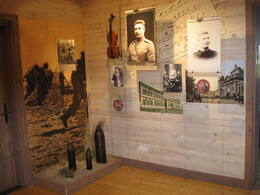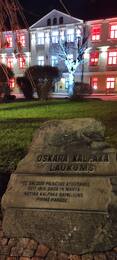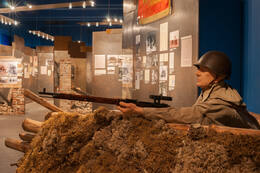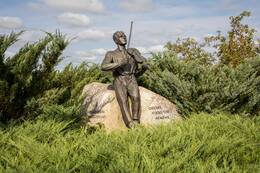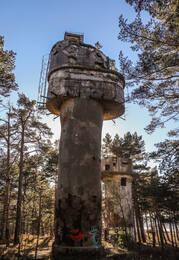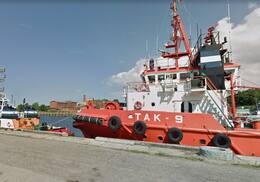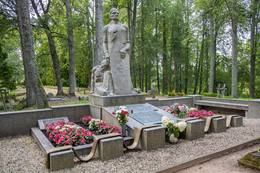Latvian Provisional Government's armed forces
I Wars of Independence
Military formations politically and ideologically loyal to the Provisional Government of Latvia within the Latvian Home Guard and the Estonian Army during the Latvian War of Independence from 18 November 1918 to 10 July 1919.
The armed forces of the Latvian Provisional Government were formed in a decentralised manner over a period of about six months, in circumstances where the Latvian Provisional Government was unable to fully control the territory of Latvia. It was composed mainly of volunteers and mobilised inhabitants from the territories of Latvia and Estonia. The Provisional Government's armed forces consisted of the South Latvian Brigade, the North Latvian Brigade and partisan units or "green armies", as well as commandant's and support services. Until 16.04.1919, the armed forces of the Provisional Government of Latvia were also considered to be the German units of the Landeswehr. In order to distinguish the ideological affiliation of the armed units of the Landeswehr, the term national troops is used in the literature.
More information sources
https://enciklopedija.lv/ section "Armed Forces of the Latvian Provisional Government, 1918–1919"
Related objects
Oskars Kalpaks Museum and Memorial Site “Airītes”
The Oskars Kalpaks Museum and Memorial Site Airītes is located between Saldus and Skrunda near the A9 highway. The exhibit has extensive information about Colonel Oskars Kalpaks and his battalion, and shows the history of the Latvian National Army and the memorial site Airītes. The exhibit reveals Colonel Oskars Kalpaks as a personality, as a soldier and as a fighter for Latvia's independence. Audio logs in Latvian, English and German are also available as part of the exhibit. They emphasize the importance of the historic events of 1918/1919 in the protecting the statehood of Latvia. The museum building has been restored.
Entry is free; guided tour – for a fee. The complex has a recreation area, a park, an obstacle course, it is possible to take various classes, and there is a seminar hall for up to 30 people.
Memorial stone in Oskaras Kalpaka Square in Saldus
O.Kalpaka Square is located in the very centre of Saldus, at the intersection of Lielā and Striķu streets.
The former market square is today a favourite place of recreation for residents and visitors of Saldus, where concerts, commemorative events and festivities are held. On 10 March 1919, Saldus became the first Latvian town liberated by Colonel Oskars Kalpaks' battalion.
On 14 March 1919, the first parade of the Latvian Separate Battalion took place in the square, and in 1992, in honour of Colonel Kalpakas, the square was named after him.
Latvian War Museum
The Latvian War Museum is located in the Old Town not far from the Freedom Monument in a historic defence building called the ‘Powder Tower’. There are 11 exhibits in the museum. There are various weapons, documents, uniforms, awards, badges and other items detailing the everyday life of a soldier in war. The Latvian War Museum is one of the oldest museums in Latvia. Its origins can be found in World War I. Museum’s collection was made up mainly of personal items of soldiers or items found on battlefields. After Latvia gained its independence the main goal of the museum became to create an exposition on the military history of Latvia and the active role of the population in protecting their land. In 1937 the museum was expanded and was technically one of the most modern museums in Europe at that time. The Powder Tower was one of the fortification towers of Riga. Some evidence dates back to 1330 where it has been mentioned as the ‘Sand Tower’. The tower was destroyed in 1621 when Riga was besieged by the Swedish Army. But in 1650 a new tower for storing gunpowder and weapons was built. After the city’s fortifications were taken down, the Powder Tower remains as one of the most important pieces of evidence of the Riga defence system.
Monument to the first battle for Latvia's independence
Located in Inčukalns, Atmodas Street 2.
On July 3, 2016, a monument to the first battle for Latvian independence was unveiled, dedicated to the Latvian Landeswehr (Die Lettländische Landeswehr), in which local Baltic Germans, Russians and Latvians, who were in units on both sides at the time, defended the newly founded state against the Bolshevik Red Army. Eižens Upmanis, the chairman of the Brothers' Graves Committee, concluded at the time that this could be the first monument to the combined Latvian and Baltic German forces in battle memorials outside the cemeteries. At that time, Lieutenant Colonel Oskars Kalpaks was appointed commander of the Latvian units of the Latvian Landeswehr, from whose units the later Latvian Army grew and formed during the Freedom Struggle.
In 1918, the entire territory of present-day Latvia had fallen into the hands of the German Empire and its troops. However, in the late summer and autumn of 1918, the situation began to rapidly turn against Germany and it was clear that it was only a matter of time before Germany would be forced to admit defeat in World War I. The Russian Empire, which Latvia was part of until World War I, had ceased to exist earlier, with the February and October revolutions of 1917. On 18 November 1918, the Republic of Latvia was proclaimed. The German army, which was located in the territory of Latvia, after the armistice with the Entente powers on 11 November 1918, was no longer motivated for further hostilities and most of its soldiers simply wanted to return to their homeland.
Under such circumstances, it was clear that the defense of Latvia depended primarily on a national guard formed by the Latvian population itself. Initially, due to their education and relatively greater ability to self-organize, the Baltic Germans living in Latvia showed the greatest initiative in forming such a national guard. Russian soldiers also joined the national guard. In order to ensure the supply of the national guard with uniforms, weapons and other necessary resources, the Latvian Provisional Government concluded an agreement with the German representative Augustus Vinnig on December 7, 1918, providing for the provision of the national guard from the German army reserves located in the territory of Latvia. This agreement indicated, among other things, that this national guard, with the official name “Latvijas zemessardze” or in German – “die Lettländische Landeswehr”, would be the armed forces of the Republic of Latvia.
The Latvian National Guard was confronted by two Latvian Red Riflemen regiments (i.e., approximately 2,000–3,000 soldiers) that had previously been experienced in World War I and the Russian Civil War. Despite the Red Army's experience and numerical superiority, the Latvian National Guard held Inčukalna in fierce battles for two days, until finally, on the evening of January 1, 1919, in order to avoid encirclement, it was forced to retreat, losing 43 killed and several wounded, most of whom were captured by the Bolsheviks, where they were killed or died of hunger or disease.
Author: Artis Buks. Material: Fieldstone. The monument is made of a large monolithic stone that was found in Ruļļi near Jelgava.
The birthplace of Colonel Oskars Kalpaks “Liepsalas” and the final resting place in Visagals cemetery
The Colonel Oskars Kalpaks family memorial in Liepsalas is located in the area between Madona and Lake Lubāns. Liepsalas is Kalpaks’ childhood home. The memorial site was established here in 1997 based on the ideas and using the resources of the colonel’s niece, Ārija Kalpaks-Grundmane (1922-2006). The site consists of various environmental objects and stone sculptures with a symbolic meaning, signifying Latvian ethical and patriotic values. The largest building houses an exhibit dedicated to the history of the Latvian War of Independence and the 22 years of Latvian freedom (1918-1940). Located in the Visagals graveyard, the monument to Oskars Kalpaks, created by Kārlis Zāle and Arnolds Dzirkals, was unveiled in 1927. The monument consists of a composition of three figures, in the centre of which is an ancient Latvian warrior holding a shield and a sword, with a falling soldier on each side. Placed obliquely on a granite base, a bronze plaque at the foot of the sculptural group contains engraved text, including a poem, dedicated to Kalpaks, by Edvards Virza. Oskars Kalpaks died on 6 March 1919 near Airītes, by the road from Skrunda to Saldus.
Karosta, the Military port of Liepāja (tour)
The Karosta is the largest historical military territory in the Baltics and occupies almost one third of the entire territory of Liepāja. The Karosta is a unique compound of military and fortification buildings on the shores of the Baltic Sea with a special meaning in the history and architecture of Latvia and the world. The Karosta features such military heritage sites as the North Pier and forts, the Redan, Karosta Prison, Karosta Water Tower, St. Nicholas Orthodox Maritime Cathedral, Oskars Kalpaks Bridge and others.
The actual berthing location of the ship “Saratov”
The actual berth of the ship “Saratov” is located in Liepāja, at Vecā ostmalā 59 near the boat piers, but the memorial is located in the immediate vicinity of the Liepāja special economic zone.
Built in 1888 in Copenhagen at the shipyard "Buvmeistar & Wain" under the name "Leopold II". In 1911, it was bought by the Russian Northwest Shipping Company and renamed "Saratov", with Latvian Aleksandrs Remess becoming the ship's captain.
In May 1915, when Liepāja was occupied by German troops, the “Saratov” was in the harbor in a damaged condition.
On January 10, 1919, the steamer “Saratov” was taken over for the needs of the Latvian Provisional Government. From April 1919 to July 1919, the Provisional Government led by K. Ulmanis was on board the ship “Saratov” after the “April 16 Coup”, which was forced to seek refuge under the protection of the Allied fleet.
On July 8, 1919, after the Provisional Government of K. Ulmanis was brought to Riga, the steamer was used in traffic between Riga, Ventspils and Liepāja.
According to the terms of the peace treaty between Latvia and Soviet Russia of August 11, 1920, the steamer “Saratov” had to be returned to the Soviet side. On January 2, 1923, the steamer was handed over to the representative of Soviet Russia. On January 15, 1923, the steamer “Saratov” was lost near Akmeņrags.
In 1936, the Latvian Maritime Department sold the shipwreck to a company that raised it and handed it over for scrap metal to the Liepāja Wire Factory.
The final resting place of Colonel Oskars Kalpaks
Located in Visagala Cemetery, Madona County
On display is a monument to Oskars Kalpaks, unveiled on July 10, 1927, by Kārlis Zāle and Arnoldis Dzirkalis - a three-figure composition, in the center of which is an ancient Latvian warrior with a shield and sword in his hands, and on both sides of him are two warriors standing. At the foot of the sculptural group, a bronze plaque is placed obliquely on a granite base, on which is engraved a text that also includes a poem by Edvards Virza dedicated to Kalpaks.
Oskars Kalpaks fell on March 6, 1919, near “Airītē”, on the side of the Skrunda-Saldus road, and his remains were transferred from the Liepāja Northern Cemetery to the family cemetery in Visagala on September 18.
The monument was unveiled by the chairman of the Colonel O. Kalpaks monument committee, General J. Balodis, in the presence of the then President of the Republic G. Zemgalas, Prime Minister M. Skujenieks, Speaker of the Saeima P. Kalniņš, Minister of War R. Bangerskis and K. Ulmanis. The foundation stone of the monument was laid on June 19, 1925. The stone for the monument was taken from the colonel's native home in Siena Marsh, on this stone O. Kalpaks loved to play the violin in his childhood.
Related stories
Colonel Kalpak's last battle near Airīte
Colonel Kalpaks was a respected figure in military circles and a true patriot. It was the spirit of patriotism and an unfortunate coincidence that led to the fatal clash between him and the German battalions, which unfortunately ended with the death of Colonel Kalpaks.
The Estonian Navy assists Latvian forces during the War of Independence
On June 23, Estonians celebrate Victory Day, thus marking the joint Latvian-Estonian victory in the Battle of Cēsis. And in this victory, the Estonian Navy played a significant role, which in this Landeswehr war, as the Estonians call it, with its courageous actions and accurate cannon fire at the mouth of the Daugava threatened the main supply routes of the German forces across the Daugava in the immediate vicinity of Riga.
Jānis Lapiņš and the first draft of the red, white and red flag of Latvia
The creation of the Latvian national flag took place during the First World War. In 1915, when creating the flags of the Latvian rifle battalions, individual artists proposed red, white and red colors for the flag designs. After the design of the educator and journalist Jānis Lapiņš, the red, white and red flag was made in the second half of 1916 by his student, a teacher at the Valmiera refugee shelter, Marianna Straumane. This is the first known and actually made Latvian national flag, which has also survived to this day.
The Battle of the Oskars Kalpaks Battalion at Lielauce
On the night of January 15, the Kalpaks Battalion fought the first battle at Lielauce, repelling the Red attack. It was the first significant battle of the Kalpaks Battalion, and the victory gave the soldiers a particularly strong morale boost.
In memory of Oskars Kalpaks
The memory of Oskars Kalpaks is preserved in many places – this is evidenced by his native Liepsalu house, a monument in the Visagala cemetery, commemorative events and beautiful concerts on March 6, the Meirānu Kalpaks Elementary School, streets in Lubāna, Madona and other cities, and on and on. But in this article – about the preservation of the memory of Oskars Kalpaks in his native region in the 1920s–1930s.
About the first Commander-in-Chief of the Latvian Army, Dāvids Sīmansons
The essays in the book "Commanders of the Latvian Army" convince us that history is significantly influenced by specific individuals. Although they were at the epicenter of the most important historical events for a short time, true Latvian patriots, with their rich military experience, managed to do a lot in the formation and strengthening of the Latvian army and in the turning points of historical events.
This story is about the first Commander-in-Chief of the Latvian Army, Dāvids Sīmansons (1859-1933).
Liberation of Northern Latgale from the Bolsheviks
On December 1, 1918, the Red Army units, based on the Red Riflemen units, invaded the territory of Latvia. In order to protect their homes, families, native region and escape from terror, the men of the Balvi area took up arms and went into the forests, the formation of the first “green” groups began. In the spring of 1919, when mobilization was announced, many men of the Balvi area found fighting in the Soviet Latvian Army unacceptable and joined the “green” groups. The Balvi, Silakrogs, Rugāji, Teteru-Dūrupe and Liepna groups were formed. The activities of the “green” groups in the Balvi area became more active in March 1919.
Artūrs Ozols' memories of the ship "Saratov"
Artūrs Ozols graduated from Riga Polytechnic and served as a naval officer (midshipman) and engineer in the Russian Black Sea Fleet aboard the warship Panteleimon. During the Latvian Liberation Struggle, he joined the Student Company. In Liepaja he put the ship "Saratov" into service. Arthurs Ozols' memoirs about the ship "Saratov" were published in the Dauagava Vanagi monthly
Akmeņrags Lighthouse and Shoal - one of the largest ship graveyards in the Baltic Sea
It was in the Akmensrags lighthouse area that, on January 13, 1923, the steamer Saratov , on which the provisional government led by K. Ulmanis took refuge when the independent state of Latvia was established, tragically ran aground and crashed.
Description of the combat activity of Vilis Narkevics on 6 November 1919
Description of the combat activity of the commander of the detachment, Lieutenant Commander Julius Rosenthal Vilis Narkevics, 3 November 1921






